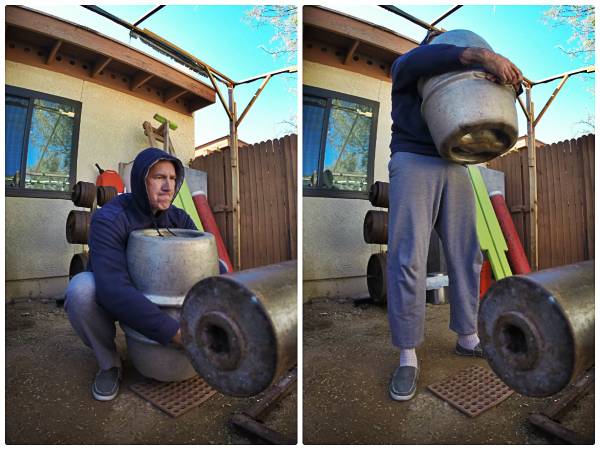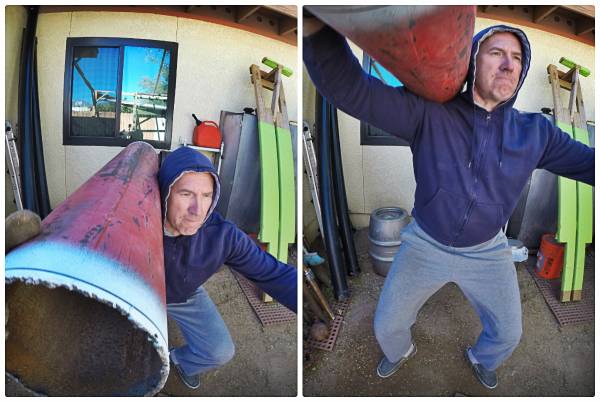Unless you’ve been living in a cave, you already know the five basic human movements:
- Push
- Pull
- Hinge
- Squat
- Loaded carry
I believe I first learned about this list from Coach Dan John. All of these basic human movements require an ability to leverage your body, an object, or both. If you want all-around strength, you need to train most or all of them.
Some people will include a sixth movement, rotation, as well as a seventh, anti-rotation. We can also break all these down into unilateral, bilateral, and even contra-lateral movements. And then there are the vertical or horizontal variations.
I like to think of the sixth movement as a catch-all for everything else. It’s one thing to push as in a bench press. But it’s entirely different to lie under a vehicle with one foot braced against a tire, the other leg sliding against the ground, and your hands lifting a transmission up at some weird angle as you also twist your body sideways to get the transmission into place. It’s a different kind of strength.
Think about shoveling, pushing a loaded wheelbarrow, or helping someone move large pieces of furniture up a set of winding stairs. Or consider chopping out old stumps by hand, digging a fifteen-foot well in the dead of winter, or removing rocks from a garden (thanks for that, Dad. It does build character). These movements are unlike anything you’ll ever do in a gym.
If you can’t use your strength outside of the gym, how strong are you, really?
Bench Bros Versus Bosu Balls
Why do I bring this to your attention? Because it’s important to remember the five basic human movement patterns are great at getting us stronger in…can you guess? Yes, training the five basic human movement patterns improves our ability to perform the five basic human movement patterns (5 BMPs).
This is all well and good, since everyone should be training these movements and endeavoring to get stronger and more proficient at them. And the carryover into other areas of sports and life is highly worth it. But even so, there are many qualities that such training does not develop. This is why nearly any sport you can think of enlists the expertise of coaches to develop sport-specific attributes.
Most people can readily see this once it’s pointed out to them. The problem arises when people go too far in one direction or the other. Some go to one end of the spectrum and only train a few of the 5BMPs and nothing else, like the upper body guys who only bench and curl. Others go to the opposite extreme and train in strange ways that have no carryover to real life, like those people you’ve seen doing one-legged squats on a BOSU ball while holding a kettlebell in the rack position as a trainer plays catch with them using a water balloon.
These performers could argue, “I love to backpack, and I might find myself carrying my pack on one shoulder, standing on one foot on a wobbly rock in the middle of a stream, and chucking a rock at a grizzly bear on the bank.” My thinking is a bit more straightforward: “You are about to get eaten.” Practice situational awareness and use the right tool for the job – in this case, bear spray and a gun.
Apply Your Strength to Any Endeavor
For most people, middle of the road is best. The two methods complement each other. Spend time training both. Most of us have the facility to get stronger by training the 5 BMPs. When you combine real world training with the 5 BMPs, you attain not only the ability to pull a good deadlift, swing a kettlebell proficiently, or press a weight overhead. You develop the ability to apply and leverage the strength you built with barbells into nearly any endeavor.
For people who play sports or work a hard physical job, just following a basic barbell routine and adding some cardio is probably enough. Their daily activity keeps them strong in a lot of weird ways. But if you don’t play sports or have an office job, you’ll need to branch out a bit in your training. That was part of the reasoning for offering up last month’s 6 Week Challenge – Loaded Carries for Farmers Strength. Hopefully you gave it a go and have noticed an improvement. My hope is you will always do some sort of loaded carries, sometimes focusing intensely on them for a few weeks at a time, and other times just doing them as a finisher once or twice per week.
The 4-Week Real Strength Squat Routine
So you should know me by now. I have another little challenge for you. For the next four weeks, I want you to drop whatever type of barbell squatting you have been doing. But don’t worry. Every time you hit the gym or your garage dungeon, you are going to squat.
You will do two types of squats, alternating them on different days.
Day One: Bear Hug Squats
Use a sandbag, rock, water- or sand-filled beer keg, or whatever odd object you can bear hug and squat. Wrap kettlebells, weight plates, or rocks tightly in a bunch of old towels and blankets and stuff it them in a duffle bag. I don’t care if you have to pick up your boyfriend or girlfriend with his or her back against your chest and your arms under her knees. Find a way, and do the bear hug squats.

You will do 5-10 reps, depending on the weight. As for the number of sets, keep going until you feel you have worked yourself pretty good. Don’t kill yourself with a max weight you can barely lift. Pick a weight that takes some effort. And don’t kid yourself with long rest periods, a light weight, and cheeseball reps any child could do. Man or woman up!
Day Two: Shoulder Squats
Lift whatever object you are using to one shoulder. Keep your zipper-line straight as you squat down deep and come back up. Use the same sets and reps as above. Just be sure to do the same amount on each side, alternating sides each set.

Control It, Feel It, Move It
Grab the object and stay tight. Control the entire movement. Do not relax until you set the object down and are standing back upright. If anything feels wonky, drop the weight and rest, or use a lighter implement.
Concentrate on the tension and amplify it. Push that energy and tension out into your entire body until you feel like you are forged out of steel. Concentrate. Feel the force you are generating. Get strong and tight internally and radiate that out to your limbs. Don’t purposely grind the weight. The amount of weight (and fatigue) will dictate the speed of your lift, so just stay tight and accelerate the object at a good pace.
Relax between sets. Briefly. Bounce and shake off the tension, or do some tumbling between sets. Then get back at it. Don’t rest too long. Work the movement and you will feel the workload.
Enjoy Your New Strength
Follow this routine for four weeks, and I guarantee you will get stronger in a way you may have never felt before, especially if all you have ever used are barbells or kettlebells. After four weeks, go back to your barbell squats. Apply what you’ve learned. You will be stronger.
Remember the feelings you felt and created while performing these two lifts and apply them to all your lifting. Apply strength, apply force. If you can feel it deep within, you will begin to control and exert this quality to an even greater extent in a variety of applications.
Become a force in and of yourself.
More Ways to Get Strong Outside the Gym:
- Loaded Carries: The Ultimate Functional Exercise
- The 4 Most Important Exercises You’re Probably Not Doing
- The Ultimate 90-Day Bodyweight Training Plan
- New on Breaking Muscle Today
Photos courtesy of Walter J. Dorey.






